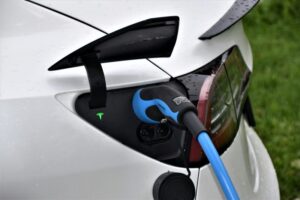Electric vehicle (EV) fleets are becoming mainstream in the UK due to fuel shortages in recent years, fluctuating oil prices and environmental concerns – but are they safe? Praxis42‘s Head of Fire Safety Rob Sherman, analyses the main concerns and risks of having an EV fleet.
Although electric vehicles are more expensive to buy, the cost can be offset over the lifetime of the vehicle, especially when charging takes place off-peak. Electric vehicles are also more environmentally friendly than internal combustion vehicles (ICEVs) because even when electricity is produced by coal the CO2 emissions are still lower than petrol and diesel vehicles.
But, for all the advantages, are electric vehicles safe?
Concerns have been growing about the fire risks associated with the lithium-ion batteries that power electric vehicles. Here we discuss the safety of electric cars and what you can do to minimise risk.
Is an EV fleet a fire risk?
 There have been worrying reports of e-bikes and e-scooters catching fire which is causing concern about the safety of electric vehicles in general.
There have been worrying reports of e-bikes and e-scooters catching fire which is causing concern about the safety of electric vehicles in general.
Like electric cars, e-bikes and e-scooters are powered by lithium-ion batteries. However, electric cars follow a different manufacturing process to e-bikes and e-scooters, and they are heavily regulated which makes fires extremely unlikely.
Research carried out in Norway, which has the highest number of EVs in the EU, found that between 2016 and 2021 there were 110 electric vehicle fires compared to 4,026 for internal combustion engine vehicles (ICEVs).
The Energy and Climate Intelligence Unit thinktank also says the fire risk posed by EVs is low compared to petrol vehicles.
But although EV fires don’t happen often, when they do happen, they are more difficult to extinguish than ICEV fires. This is due to the chemical reaction that takes place when a lithium-ion battery catches fire. It has also been found that 13% of EV fires reignite.
Since EV fires take longer to put out there is an increased risk of damage to nearby buildings. In addition, these fires require more water to put out, and research has found that the water used to extinguish EV fires may then need to be decontaminated due to the chemicals in the battery.
How can you minimise EV fire risks?
Manufacturers continuously implement safety measures and advancements in EV technology to mitigate risks. By conducting a thorough risk assessment and implementing appropriate protection measures, you can further enhance safety.
In RC59 – Recommendations for fire safety when charging electric vehicles, the Fire Protection Association recommends that organisations consider:
Emergency access
It is crucial to maintain clear and unobstructed pathways for emergency access and egress.
Clearly mark emergency access points and egress routes with appropriate signage to ensure they remain visible and easily identifiable. Ensure that the charging area is easily identifiable from main thoroughfares to facilitate rapid response.
Regularly inspect the charging area to make sure there are no obstructions blocking emergency access or egress routes. Employ cable management systems to neatly organise and secure charging cables, preventing them from sprawling across pathways or becoming trip hazards.
Fire equipment
 Install automatic fire detection and warning systems in charging areas. Consider integrating fire suppression equipment, such as extinguishers or hydrants near charging bays.
Install automatic fire detection and warning systems in charging areas. Consider integrating fire suppression equipment, such as extinguishers or hydrants near charging bays.
Emergency planning
Develop an emergency action plan specific to EV charging areas. This plan should detail evacuation procedures, emergency contact information, and roles and responsibilities of personnel during fire incidents.
Ensure that all relevant staff are trained in fire safety protocols and evacuation procedures and know the procedures for isolating power to charging stations. Clear signage and mapping should be provided to help staff quickly locate the charging areas during emergencies.
Encourage open communication between security personnel, facilities managers, and other relevant stakeholders to facilitate information sharing and updates to EV charging safety procedures.
Visibility
Parking bays should be clearly marked to reduce the risk of congestion and make it easy for drivers to identify what parking spaces are specifically for EVs.
Maintain clear sightlines and adequate lighting in transition zones to enhance visibility and safety for all users, especially during low-light conditions or emergencies.
Isolation systems
Make sure power isolation systems can be accessed away from charging points, so power can be safely shut down if there is a fire.
Accessibility
Transition zones should be at least 1,200mm wide so disabled drivers can get in and out of their vehicles safely. Install accessibility features such as tactile paving or ramps to facilitate access.
Position transition zones strategically, ensuring convenient access to amenities such as charging stations, pedestrian walkways, and building entrances.
Location

It is advisable to position charging bays in external areas away from buildings. This helps to prevent fire spreading to structures and minimises potential damage.
Choose open areas with ample ventilation and space to accommodate charging equipment and multiple vehicles safely. Avoid congested or enclosed spaces that may exacerbate fire hazards or impede emergency access.
Design charging bays with clear and unobstructed access routes for emergency vehicles. Maintain wide pathways and ensure that there are no barriers or obstacles hindering access to the charging area.
Position charging bays close to charging points to minimise the need for long charging cables. Ideally, EVs should be able to park directly adjacent to the charging equipment, reducing the risk of tripping hazards and cable damage.
Flammable materials
Ensuring that no flammable or combustible materials are stored within designated charging areas for an EV fleet is critical.
Flammable or combustible materials stored near charging areas can act as ignition sources. In the event of a malfunction during charging, these materials can accelerate the spread of fire, posing significant risks to personnel, property, and the environment.
Clearly designate charging areas as “No Storage Zones” for flammable or combustible materials. Use signage and markings to communicate this restriction effectively to personnel and visitors.
Out of hours
If a fire occurs when a site is unattended there may be delays in responding, leading to more significant damage. There is also the risk of malicious damage to charging points and your electric vehicle fleet when nobody is on-site.
Risk control measures may include enhanced monitoring systems, remote access controls, and automated shutdown procedures to mitigate fire risks in the absence of personnel.
To ensure fire and rescue services attend an incident quickly, you could link your fire detection and fire alarm system to an alarm receiving centre (ARC).
Consider installing CCTV camera surveillance and security lighting around charging areas to deter intruders. Motion-activated lighting can provide an added layer of security by illuminating areas when movement is detected.
Servicing and maintenance
Regular servicing and maintenance of EV chargers must be carried out by a competent electrician with expertise in electrical installations and equipment.
Internal installations of EV chargers should comply with the requirements of BS 7671, also known as the IET Wiring Regulations. These regulations specify the standards for electrical installations in the UK, including those related to EV charging.
Compliance with BS 7671 ensures that EV charging installations meet the necessary safety standards and requirements, such as appropriate wiring methods, circuit protection, and earthing arrangements.
Employees should be trained to conduct daily visual inspections of charging equipment to identify any signs of damage, wear, or defects and know how to report concerns promptly.
The Safety Conversation Podcast: Listen now!
The Safety Conversation with SHP (previously the Safety and Health Podcast) aims to bring you the latest news, insights and legislation updates in the form of interviews, discussions and panel debates from leading figures within the profession.
Find us on Apple Podcasts, Spotify and Google Podcasts, subscribe and join the conversation today!

 There have been worrying reports of
There have been worrying reports of  Install automatic fire detection and warning systems in charging areas. Consider integrating fire suppression equipment, such as extinguishers or hydrants near charging bays.
Install automatic fire detection and warning systems in charging areas. Consider integrating fire suppression equipment, such as extinguishers or hydrants near charging bays.
